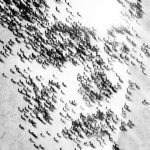Building Califia – A Model Arcology in Northern California
Urban designer Paolo Soleri developed a methodology of ecological city design in the late 1960s he called “arcology” (architecture+ecology) and sought to test his ideas with Arcosanti, a pioneering model town in the Arizona desert 60 miles north of Phoenix. Although the full build out of Arcosanti has never been realized, it houses Soleri’s extensive archive and has served as an inspiring “urban laboratory” and experiential learning center, hosting workshops and events and providing tours to hundreds of thousands of visitors.
In the mid-2000s our San Francisco-based Green Century Institute on sustainable communities explored the development of Califia, a model arcology in Northern California. The idea was to learn from Arcosanti and related projects, and tap into the substantial cultural and business resources of the Bay Area to create something truly extraordinary: a model community that the rest of the world might participate in, learn from and build upon. Funded with private donations and the dedicated work of a small team, we embarked on a two-year research and outreach effort, held a design conference with international attendees, developed extensive proposal material and began to gather a team and explore potential partnerships. From the 2006 project overview documentation:
“In this unprecedented era of global climate change and societal unrest, now more than ever there is an urgent need for working design solutions to implement large scale sustainable urban projects. Califia is envisioned as a world-class real estate development and model ecocity that synergizes leading edge green architectural design, advanced energy and information systems, and a new generation of innovative social frameworks and civic organizations that encourage a healthy and ecologically sustainable lifestyle.
The project will be a bold pioneering development that will draw upon the unique, high-yield resources of the San Francisco region, a hotbed of evolutionary technology as well as environmental and social innovations. As home to many of the world’s top researchers, entrepreneurs and institutions that are already building a sustainable world, the Bay Area is the ideal region in the U.S. for this type of development. Califia will bring the fruits of this diverse and world-changing culture into a high visibility and concrete living model for a new urban lifestyle.
Califia will combine a variety of residential housing configurations with a full complement of civic, retail, and commercial spaces. This dramatic mixed-use complex will integrate advanced energy, transportation, and utility systems into exquisitely designed dense urban spaces, along with natural elements and close access to an open landscape of parks and gardens.”
But the limitations of our small org, and the eventual 2008 economic collapse (which sidelined countless green initiatives and funding programs) eventually brought our efforts to a standstill.
Might now, a decade further down the road, be the time to reconsider such a visionary enterprise? With the specter of sea-level rise at our doorstep and the prospect of millions of climate change refugees, arcological design can and should be a vital piece of the puzzle when it comes to planning and building the required new urban settlements, and refashioning existing cities for improved resiliency. But how can we elevate the holistic planning methodology Soleri proposes with arcology to real-world application vs. its appearance in science fiction novels, online games and futurist writings?
There are a number of noteworthy major urban developments that incorporate advanced green design and technology innovations, such as those showcased at the Ecocity World Summit. The bi-annual conference is produced by Eco-City Builders of Berkeley California, founded by early Paolo Soleri adept Richard Register. Executive Director Kirstin Miller describes their current areas of focus as “developing a neighborhood approach to transforming existing cities towards ecocities, building urban metabolic information systems to inform systemic transformations, cultivating regional circular economies and promoting eco-citizenship and peer-to-peer urbanism.” Whereas the conferences, which are held in different cities every two years (the 2017 event was in Melbourne, Australia, and the upcoming October 7-9, 2019 Summit will be in Vancouver, BC, Canada), are definitely contributing to a growing movement among metropolitan areas to design for sustainability, there are still no major self-contained, integrated, fully regenerative urban centers to serve as models for a wholly new paradigm of truly ecological cities.
Various components of ecological habitat development and community innovations are being invented, tested and refined across the wide range of smaller “eco-village” projects worldwide, connected via the Global Ecovillage Network and the Fellowship for Intentional Community. The various off-the-grid methodologies, permaculture design principles, community currencies, hard capital vs. social capital ownership agreements, and other new/old ideas are being hammered out in countless well-intended but still mainly modest and idiosyncratic community initiatives.
The seasteading movement to build floating cities is taking shape. A new generation of visionary city planners and architects (such as Michael Pawlyn and Perkins+Will) are raising the resilient design bar. Our tech superheros Jeff Bezos and Elon Musk are shooting for the stars with ambitions for space tourism, Mars settlements, asteroid mining etc. This is big thinking, and big actions are indeed being taken.
But still. We have no large-scale, on-the-ground ecocity models that employ the whole systems, biomimetic approach of arcology, and engage the kind of major private-public partnerships and innovative development strategies that are required for such massive multi-stakeholder projects. Is it because we would rather watch futuristic Netflix shows instead of actually dealing with our REAL “sci-fi” future?
I once met the head of a major television cable network at a “conscious media” gathering in Los Angeles, where he paid tribute to Paolo Soleri. I suggested a film or cable series reality show that could devote part of its budget to building and promoting the support of a model arcology. I was only half-joking. (Game of Thrones episodes at $10mm each?) There is no question that a media program associated with such a development would be vital to the model city’s mission as a catalyst for similar projects. When my friend John Allen and his Biosphere2 crew built perhaps the most ambitious privately developed research project in modern times – a self-contained miniature Earth – the international media coverage of the launch of the initial 1991 2-year mission with 8 “biospherians” being sealed inside the closed ecosystem was huge. Though initially reported by international networks in the way they might cover a moon landing, in the end the media narrative took a more sensationalized turn. Even so, it was a great example of the kind of interest mainstream society takes in a truly novel, ground-breaking enterprise.
With the world’s population steadily moving into growing urban centers, our cities represent the true network of civilization vs. nation-states and the corporate constructs of global capitalism. Rethinking urban centers and the relationship they maintain with the natural environment is one of the key levers to engage a sustainable civilization. We have to break out of the constraints of prohibitive zoning and building codes and investment parameters that have all been dictated by traditional residential and commercial development interests. We need radical new models.
California is for so many reasons the obvious place for such ideas and visions to take root. We have been inventing the future for a long time here. Now is the time to think even bigger. Come on Silicon Valley! Enough already with the self-driving cars, connected gadgets and “disruption!” Come on Bay Area culture shapers, eco-warriors, crypto-finanseers and social change visionaries! Let’s do something truly meaningful and impactful!
It is time to reinvent the city.
Image – Solare: Lean Linear City by Paolo Soleri







